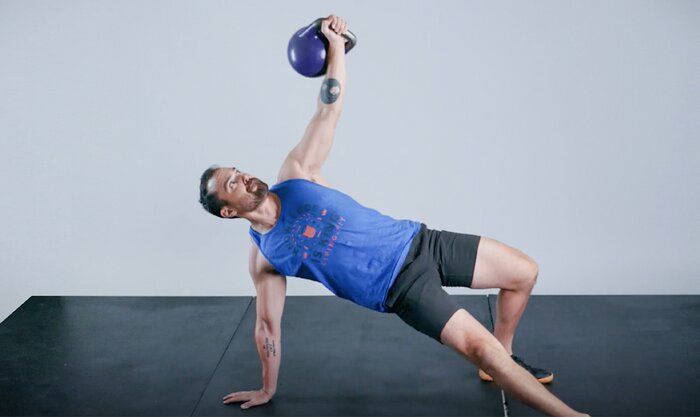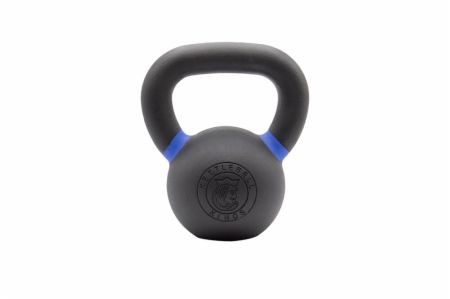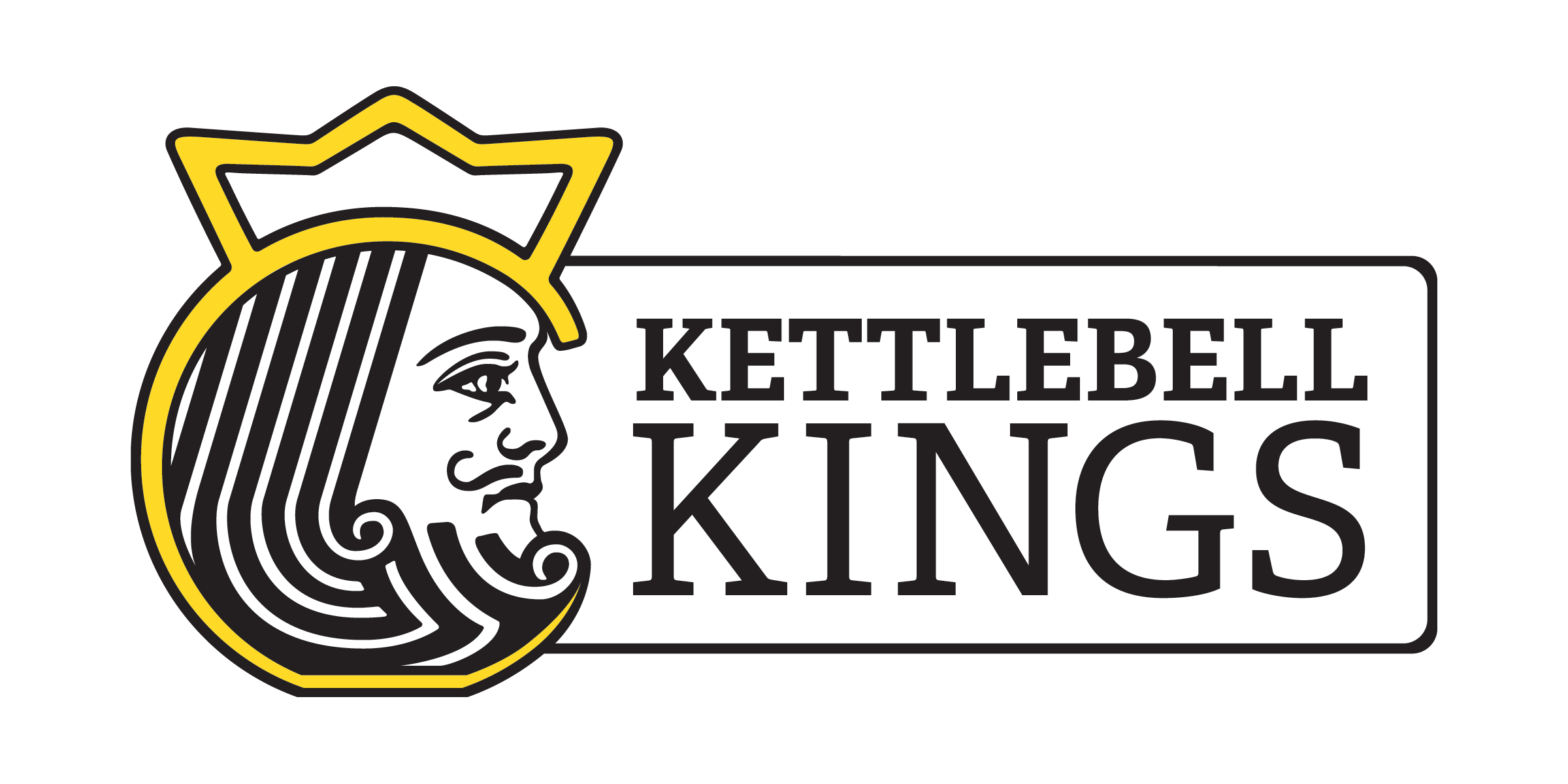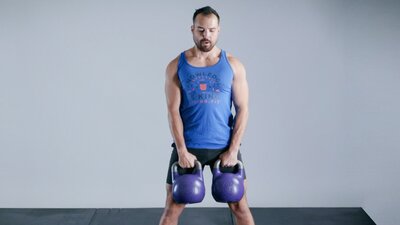Every passing day, more people are buying their first kettlebell—or their third, or their fifteenth. That's not likely to change any time soon. So the question of what this unique weight is best for is more timely than ever.
So, here's my answer, as someone who has been training with, and training people to use, kettlebells for years: They do an amazing job of creating a stronger, more athletic person with an incredible amount of accessibility for all populations and experience levels.
Can you get everything you need from the kettlebell? Technically yes, but that's not what this article is about, so don't get rid of your bands, bars, and bikes just yet. I'm just going to provide my personal treasure map toward getting stronger, leaner, and bigger with this seemingly simple chunk of iron—and it's not going to be through the same old moves you probably already know.
Why train with kettlebells?
Those of us who favor kettlebells have heard it countless times: "I can just do everything with dumbbells!" Hold on, buckaroo. You'll be missing out on some unique gains from the kettlebell with that attitude. Let's take a look at what makes the kettlebell so special.
Offset handle: While a dumbbell simply sits in a fixed point in your hand, the kettlebell handle essentially creates a new joint. In ballistic exercises (cleans, snatches, hand-to-hand swings) this poses an intense challenge to your grip, elbows, and shoulders as you have to manipulate that bell rotationally around the limb. This can help create an incredible amount of strength and body awareness, while also strengthening large and small muscles, as well as the joint complexes, in a unique way.
Many functions, little floorspace: The compact nature of the kettlebell lends itself to a diverse and balanced training approach. A single bell, no matter if it's 25, 50, or 100 pounds, takes up less space than an equivalent dumbbell, and lends itself more comfortably to ballistic, athletic movements like cleans, swings, and snatches. However, it's also just as comfortable for strict, smooth presses and rock-bottom squats. What's more, heavy single-kettlebell work builds core and upper back strength better and more safely than just about anything.
Great for exploring and improvising: A style of kettlebell training that's exploding in popularity right now is the "flow." This is really just another name for a complex, where you perform multiple movements without setting the bell down. But a flow is more free-flowing and lends itself to incorporating all types of athletic and three-dimensional movements. Whatever you call these routines, they are bona fide fat-shredders that challenge even the most experienced athlete. And the fun doubles when you add a second bell.

Eccentric loading: More than any other free weight, the kettlebell allows you to work the eccentric (stretching) phase of the hip hinge repeatedly with movements like the swing. This enables you to build posterior strength and endurance while simultaneously increasing your hamstring flexibility. My clients are almost always able to touch their toes after a few weeks of incorporating kettlebells without much, if any, direct stretching, and without any complaints about pain in their lower backs. As a trainer, that's a win-win.
The only drawback with kettlebells is that there is more of a learning curve than some other gym tools, especially when we're performing anything ballistic or putting the bells overhead. Plenty of people are guilty of seeing a cool move, picking up a bell, and just going for it. This can lead to looking like a fool at best, but even worse, getting injured and becoming convinced that kettlebells are useless or dangerous.
So, you've got a bell in your hands—or at least in your garage, or just at your local gym. Now what do you do with it? Below are some of my favorite movements to help people see the unique benefits of the bell, broken down into three categories of fat loss, muscle gain, and strength gain.
Each recommendation comes in two varieties:
- Fundamental: A great place to start and build from.
- Next-level: Increased challenge and intensity for when you or your client are ready.
My recommendation is to take a move you'd do with a dumbbell and use one of these kettlebell variations instead so you can start getting a feel for it. If you're doing conditioning work, replace one of your interval workouts on the rower or bike with a ballistic kettlebell session, and watch the sweat pour and fat melt.
Give yourself a few sessions to master the movement before ramping up the volume big time, since "too much, too soon" can be easy to fall into with even a light kettlebell. Remember, one of the great lessons of kettlebell training is that less can be more.

What are the best kettlebell exercises for weight loss?
Kettlebells are inextricably linked to weight loss in many people's mind. But if you think that their usefulness begins and ends with the swing, you're not getting the whole story. Here are a couple of moves that you may not have tried, but which I've found to be unbelievably effective at stripping off unwanted body fat.
Fundamental: Two-Handed Hang Clean to Squat
What it works: Shoulders, arms, back, glutes, hamstrings, quads, core
Benefits:
- Allows the athlete to work on timing and coordination allowing them to perform more complex, calorie-burning workouts.
- Can be used as an intensifier/cardio acceleration after heavier movements.
- Hits multiple movements and muscles simultaneously to increase caloric expenditure.
- Works the core as you fight to maintain balance.
This movement is a staple for my fat-loss clients, as it mimics the mighty barbell clean but in a far more accessible way for most people. You're not going to be able to go nearly as heavy as a barbell, so you're going to increase the reps or time. There are a lot of moving parts here that will help increase overall caloric expenditure while simultaneously improving your coordination and timing. It's the perfect blend for serious athletes of all types, and the rest of us, as well.
Why two hands? The assisted position will help you stay in control of the bell so it doesn't slam on your forearm—a common complaint when people are starting out with kettlebells. It allows you to guide the bell as you rotate your arm to find a space for the kettlebell to sit. As your technique improves, you'll be able to speed this up or do it with just one arm, making it even more challenging.
Next-Level: Alternating Staggered Rotational Swing
What it works: Shoulders, back, hamstrings, glutes, quads, core, grip
Benefits:
- Same benefits as the swing, but with an increased body awareness challenge.
- Adds footwork to improve athleticism and balance.
- Helps build rotational power.
The kettlebell swing is one of the main reason to use kettlebells—that's no surprise to anyone who does them. There's nothing like it to build backside power and strength while pushing your heart rate through the roof. But here's one truth that you don't hear enough in the kettlebell community: There are plenty of ways to progress the swing beyond simply doing more of them, doing heavier ones, or doing them faster or harder.
For example, you can change your body position. I find that performing the swing in an alternating staggered-stance position, with a slight rotation, helps the movement carry over to just about every athletic endeavor. However, you can still do it fast, which means this is great for building explosive power if done heavy enough, or increased fat-loss if performed long enough. This is a great movement to splice into your conditioning circuits.
What are the best kettlebell exercises for muscle gain?
There's a common misconception that you can't build muscle with kettlebells, but my philosophy is, "the methods are many, principles are few." In other words, your muscles don't care what tool you use, as long as you stimulate them enough with the right amount of intensity and volume, give them enough time to recover, and feed them properly. Accomplish that, and you're sound as a pound—or in this case, a kilogram.
Here are two of my favorite movements for putting some meat on your bones.
Fundamental: Assisted Dead-Start Clean and Push Press
What it works: Shoulders, back, glutes, hamstrings, quads, core
Benefits:
- Full-body movement with an emphasis on the upper body.
- More approachable than strict pressing for beginners.
- Unilateral work increases core challenge.
- Holding the bell in the rack is great for posture and bracing.
Few movements are as powerful as the clean and press. And the kettlebell offers a unique advantage that you can work one side at a time. Sure, you can do that with dumbbells, but the anatomy of the kettlebell lends itself to a more comfortable "racked" position, allowing you to pick up and hold heavier weights.
Similar to the assisted clean to squat, you'll be using your free arm to help coordinate the bell from the ground to the rack position, where it sits nicely between your forearm and upper arm. Using your free arm will also help you avoid curling the kettlebell up, a common approach for beginners that feels awful and doesn't work very well.
The dead-start clean is a phenomenal exercise for building the glutes, hamstrings, back, and shoulder muscles. You won't be using as much momentum as the traditional kettlebell clean since the bell won't travel between the legs in a loaded hinge. This will require a faster start as you create the momentum for each rep, stimulating fast twitch muscle fibers.
Combine it with a push-press, and you've got a full-body exercise that can stimulate overall strength and size and can go surprisingly heavy once you get the basics down.
Advanced: Double Hang Clean to Double Rotational Press
What it works: Pretty much everything
Benefits:
- Spans multiple movement patterns and muscles.
- Double kettlebells increases overall load.
- Serious time under tension.
- You don't need to go very heavy for it to be challenging.
- Combines the benefits of unilateral and bilateral work.
- It's a multiplanar, athletic movement.
Double-kettlebell work multiplies the overall load on your body, making it a natural progression for more advanced lifters. But the evolution doesn't have to stop at just doing double presses or alternating presses.
The alternating rotational press is a favorite of mine since it gives the benefits of unilateral work while still challenging your core and trunk as you hold one bell in the racked position while pressing the other. This increased time under tension will help in your battle for shoulder, arm, and back size. The double hang clean will require you to use a lighter pair of bells, which makes it more accessible for most people—but also means that your sets can last longer (lucky you). The shortened range of motion on the hang clean will make it more challenging to your upper back and shoulders, while still giving plenty of stimulus to build your hamstrings and glutes.
What are the best kettlebell exercises for strength?
As powerlifters love to point out, building size doesn't inherently mean it comes with equal amounts of strength. With that said, strength does have one advantage over muscle gain; it's easier to develop without increasing your calorie intake and while maintaining a decent level of conditioning.
While this might not be the goal for every lifter, it is the goal for many athletes who want to get stronger but stay in a weight class—or just in their wardrobe. These two movements are staples with the MMA fighters I work with, but also work for just about anyone looking for strength that carries over into everything else they want to do.
Fundamental: Staggered Tripod Press
What it works: Shoulders, chest, glutes, hamstrings, quads, core
Benefits:
- Builds exceptional shoulder stability and serious core strength.
- Builds strength in the support arm as you create a strong connection to the ground.
- Builds glute and hip strength.
- Builds full-body coordination and awareness.
The get-up is often touted as the best kettlebell exercise for building overall strength due to the stability it requires through multiple positions. And I agree that it's great at that. However, it can be too much for beginners, and like the swing, it's too easy to look at as the be-all, end-all. For many people, breaking down the get-up into its component parts and adding in a press gives more bang for the buck and a more concentrated dose of best parts of the movement.
From a seated position with one leg extended, you're going to extend your hips and press. So not only are you building core and shoulder strength, you're also building shoulder strength in your planted arm as you stabilize your body. This is a phenomenal movement that will challenge you from head to toe.
Next-Level: Double Overhead Back Lunge
What it works: Shoulders, back, glutes, hamstrings, quads, core, grip
Benefits:
- Double weight creates a total-body challenge.
- Creates phenomenal shoulder stability.
- Creates a stronger core.
- Builds balance and coordination.
You can consider this another deconstruction of the get-up, in that while the get-up is complicated, this movement is deviously simple. Simply take a pair of bells, get them overhead and perform lunges.
Easy, right? Not at all. This move requires—and builds—shoulder stability as a well as core and lower-body strength to make sure you can stay tight while moving from high to low. This makes it one my go-to moves when a client needs to build full-body strength with as little wear and tear as possible.
And yes, this is one that is definitely more effective with kettlebells than dumbbells. The kettlebells sit on the forearms, helping pull your shoulders back to a stable overhead position, allowing you to build up to using heavier weights than you could with dumbbells. Core, balance, coordination, bracing—this move has it all.
If you'd like to learn more about kettlebells and how to incorporate them into your training, or if you're a coach who would like to offer more value to your clients, check out the Living.Fit Fundamentals and Advanced Kettlebell Courses. These comprehensive systems teach you how to safely and effectively use kettlebells, avoiding the common pitfalls most trainees make while using these essential tools for what they're best at.


